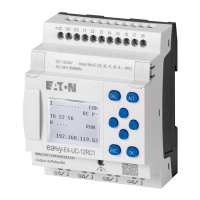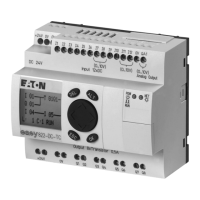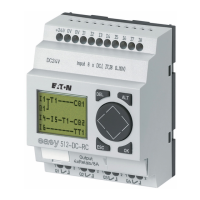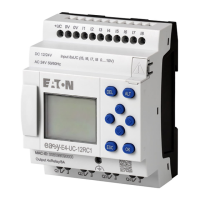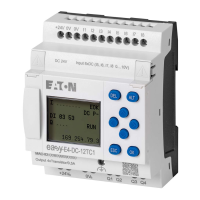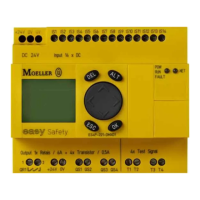4 Wiring with
4.10 Timing Relay
Operating instructions 05/10 MN05013003Z-EN www.eaton.com 123
You integrate a timing relay into your circuit in the form of a contact and coil.
4.10.1 Parameter display and parameter set for a timing relay:
In the parameter display of a timing relay you can change the mode, the time
base, the time setpoint 1, time setpoint 2 (if necessary) and the enable of the
parameter display.
4.10.1.1 Compatibility between the easy400 and easy500, easy600 and easy700 timing relay
parameter displays
New functions have been added to the parameter display of easy500 and
easy700. The easy400 and easy600 parameters can be found at the
following points.
Parameter display in RUN mode:
Contact Coil
T1 - T16 Contact of a timing relay
TT1 - TT16 Enable, timing relay trigger
RT1 - RT16 Reset coil of the timing relay
HT1 - HT16 Stop coil of the timing relay (H = Stop , S means the Set coil function)
→
Avoid unforeseeable switch states. Only use each coil of a relay
once in the circuit diagram.
T1 X S +
I1 00.00
I2 00.00
T:
T1 Timing relay number 1
X On-time mode
S Time range in seconds
+ • + appears in the PARAMETER menu.
•
- does not appear in the PARAMETER menu
I1 Time setpoint 1:
• Positive value via constant or variable from I7, I8, I11, I12 (analog inputs).
• Variable via actual value T1 to T16, C1 to C16.
I2 Time setpoint 2 (with timing relay with 2 setpoints):
• Positive value via constant or variable from I7, I8, I11, I12 (analog inputs).
• Variable via actual value T1 to T16, C1 to C16.
T: Display of actual value in RUN mode
easy400/600-
Parameters
easy500/700-
Parameters
T1 =T1
X =X
S =S
AA.BB =AA.BB
+ =+
X w g
S nAA.BBn
Ä sTRG dT1
yRES b+
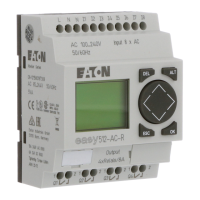
